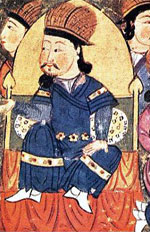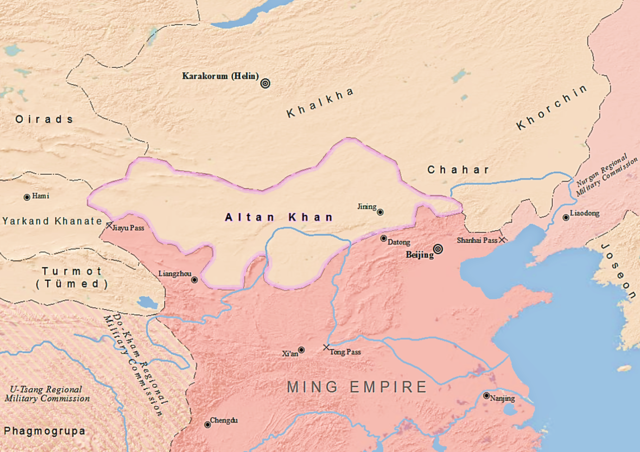Altan Khan
Shunyi King (順義王) From Wikipedia, the free encyclopedia
Altan Khan of the Tümed (2 January 1508[1] – 13 January 1582;[2] Mongolian: ᠠᠯᠲᠠᠨ ᠬᠠᠨ, Алтан хан; Chinese: 阿勒坦汗), whose given name was Anda (Mongolian: Алтан (Аньда);[3] Chinese: 俺答), was the leader of the Tümed Mongols[4][5][6] de facto ruler of the Right Wing, or western tribes, of the Mongols, and the first Ming Shunyi King (順義王). He was the grandson of Dayan Khan (1464–1543), a descendant of Kublai Khan (1215–1294), who had managed to unite a tribal league between the Khalkha Mongols in the north and the Chahars (Tsakhars) to the south. His name means "Golden Khan" in the Mongolian language.
| Altan Khan | |
|---|---|
| Shunyi King (順義王) | |
 | |
| 1st Ming Shunyi King (順義王) | |
| Reign | 21 April 1571 – 13 January 1582 |
| Predecessor | First |
| Successor | Sengge Düüreng |
| Born | 2 January 1508 |
| Died | 13 January 1582 |
| Spouse | Erketü Qatun |
| House | Borjigin |
| Father | Bars Bolud Jinong |
| Religion | Tibetan Buddhism |

Consolidation of power
Summarize
Perspective
Borjigin Barsboladiin Altan was the second son of Bars Bolud Jinong, and a grandson of Batumongke Dayan Khan who had re-unified the Mongolian nobility in an attempt to regain the glory of the Yuan dynasty. Altan Khan ruled the Tümed and belonged to the Right Wing of the Mongols along with his elder brother Gün Bilig, who ruled the Ordos. After Gün Bilig's death in 1542, Altan became the de facto leader of the whole of the Right Wing and was given the title, "Tösheetü Sechen Khan".
When Bodi Alagh Khan, the Khagan of the Mongols from the Chahar, died in 1547, Altan forced Bodi Alagh's successor Darayisung Küdeng Khan to flee eastward. In 1551 Darayisung made a compromise with Altan in exchange for giving the title "Gegeen Khan" to him.[7] Altan Khan, who controlled the Ordos tumen of the Huang He or Yellow River was well placed to keep pressure on the Chinese and the Oirat Mongols in Tibet while developing both agriculture and trade.[8]
Altan Khan also founded the city of Köke Khota (Hohhot, meaning "The Blue City"), now the capital of the Inner Mongolia Autonomous Region of the People's Republic of China.[9] There is an impressive statue of him in one of the city's main squares.
Relations with Ming China
Summarize
Perspective
Altan Khan led raids into the Ming dynasty in 1529, 1530 and 1542 returning with plunder and livestock. In 1550 he crossed the Great Wall and besieged Beijing, setting the suburbs on fire.[10] In 1552 Altan Khan gained control of the remains of Karakorum, the old Mongol capital.[11] Longqing Emperor, the reigning emperor of the Ming dynasty, was forced to grant special trading rights to the khanate, which allowed it to trade horses for silks, further strengthening it economically. After grandson Bǎhànnàjí (把汉那吉) was surrenderred to the Ming, wife of Altan Khan, Khatun (克哈屯) was afraid that Bǎhànnàjí would be killed by the Ming.[12] Han official Zhao Quan (赵全) under Altan Khan suggested to attack Ming to get Bǎhànnàjí back.[13] After verifying the fact that Bǎhànnàjí was appointed as a commander of the Ming, Altan Khan told Bao Chongde (鲍崇德) that if he was betowed as a king of the Ming, he would become official and follow order of the Ming, and never betray. He also broke an arrow as a pledge, saying if he broke his promise, he would be broken like the arrow.[14] In 1570 (隆慶四年), event Anda Feng Gong (Chinese:俺答封贡) occurred after Grandson Bǎhànnàjí returned to Altan Khan, and Han officials including Zhao Quan under Altan Khan were executed the next day by the Ming.[relevant?] In 1571, Altan Khan agreed to pay tribute to the Ming, and the title Shunyi King ("king who conforms to righteousness") and seal of authority were granted to him by the Longqing Emperor (March 4, 1537 – July 5, 1572), the 12th emperor of China (Ming dynasty). The emperor also gave Altan Khan's new capital a new name, Guihua, meaning "return to civilization".[15][4][16][17] More than 60 other people including Altan Khan's brother and nephew were also assigned with high official positions of the Ming.[18] As requested by Altan Khan, his son Sengge Düüreng was also granted official position from Ming.[19] Grandson Bǎhànnàjí was appointed as General by the Ming and continued to command as before.[20]
Altan Khan's submission to the Ming dynasty in 1570 was largely nominal, as he retained significant autonomy. While he acknowledged Ming authority and paid tribute, the arrangement was mutually beneficial, with the Ming offering trade privileges. In reality, the Ming had little control over Altan Khan's actions or policies.
Chinese histories maintain that Altan-qan surrendered to the Ming (in 1570). It is true that Altan-qan accepted a number of conditions laid down by the Chinese. But it was far from "surrender." In fact, the Ming were extremely glad to be able to come to terms with the Mongol leader. Prof. Lattimore pointed out to me in a letter dated January 25, 1956, that Altan-qan did not accept Ming control. On the contrary, the Ming were anxious to keep their part of the agreement even if the Mongols were not easy to appease. The Mongols "recognized themselves as vassals," and "paid the tribute;" but the advantages they got in return were very substantial. One might wonder who was paying tribute to whom.
— Henry Serruys, Chinese in Southern Mongolia During the Sixteenth Century, Monumenta Serica, Vol. 18 (1959), pp. 1-95.
Alliance with the Gelug
Summarize
Perspective

Altan Khan is particularly remembered for establishing ties between Mongolia and the religious leaders of the Tibetan Gelug order. He became very interested in the Gelug, and Beijing was happy to provide him with Tibetan lamas (teachers), Tibetan scriptures, and translations.[4] Altan Khan first invited Sonam Gyatso to Tümed in 1569, but apparently he refused to go and sent a disciple instead, who reported back to him about the great opportunity to spread Buddhist teachings throughout Mongolia.[22][verification needed]
In 1573, Altan Khan took some Tibetan Buddhist monks prisoner.[23][relevant?]
Sonam Gyatso accepted Altan Khan's invitation to Tümed in 1577.[24] Altan Khan later had Thegchen Chonkhor, Mongolia's first monastery, built at the place of the meeting.[25] Also, the ruler of the Khalkha Mongols, Abtai Sain Khan, rushed to Tümed to meet the Dalai Lama. The Erdene Zuu Monastery was built by him in 1586, at the site of the former Mongol capital of Karakorum following his adoption of Buddhism as the state religion.[26] This monastery is also often (wrongly) referred to as the first monastery in Mongolia and it grew into a massive establishment. In 1792, it contained 68 temples and some 15,000 lamas.[27]
Sonam Gyatso publicly announced that he was a reincarnation of the Tibetan Sakya monk Drogön Chögyal Phagpa (1235–1280) who had converted Kublai Khan. He also claimed Altan Khan was a reincarnation of Kublai Khan (1215–1294), the famous ruler of the Mongol Empire and Emperor of China, and that they had come together again to cooperate in propagating the Buddhist religion.[28][29]
Altan Khan designated Sonam Gyatso as "Dalai" (a translation into Mongolian of the name Gyatso, meaning "ocean") in 1578,[24] and in October 1587, as requested by the family of Altan Khan, Gyalwa Sonam Gyatso was promoted to Duǒ Er Zhǐ Chàng (Chinese:朵儿只唱) by the emperor of China, seal of authority and golden sheets were granted.[30] As a result, Sonam Gyatso became known as the Dalai Lama which, since then, has been used as a title – frequently translated into English as "Ocean of Wisdom". The title was also posthumously given to Gendun Drup and Gendun Gyatso, who were considered Sonam Gyatso's previous incarnations.[31] Thus, Sonam Gyatso was recognized as being already the 3rd Dalai Lama.[31]
Sonam Gyatso never returned to Tibet but remained proselytizing among the Mongols.[31] The Tümed Mongols and their allies were brought into the Gelug tradition, which was to become the main spiritual orientation of the Mongols in the ensuing centuries.[31]
Sonam Gyatso's message was that the time had come for Mongolia to embrace Buddhism, that from that time on there should be no more animal sacrifices, there must be no taking of life, animal or human, military action must be pursued only with purpose and the immolation of women on the funeral pyres of their husbands must be abolished.[32] He also secured an edict abolishing the Mongol custom of blood-sacrifices.[33] "These and many other such laws were set forth by Gyalwa Sonam Gyatso and were instituted by Altan Khan."[34]
A massive program of translating Tibetan (and Sanskrit)[35] texts into Mongolian was commenced, with letters written in silver and gold and paid for by the Dalai Lama's Mongolian devotees. Within 50 years virtually all Mongols had become Buddhist, with tens of thousands of monks, who were members of the Gelug order, loyal to the Dalai Lama.[25]
When Sonam Gyatso died in 1588, his incarnation – and thus, the new Dalai Lama – was Altan Khan's great-grandson.[31]
Death
Altan Khan died in 13 January 1582, only eleven years after becoming Shunyi King of Ming China, and only four years after meeting with the Third Dalai Lama. He was 74 or 75 years old at the time.[28]
Succession
Altan Khan's title Shunyi Wang (順義王) was succeeded by his son Sengge Düüreng who was supported by the Ming court of China.[36] Altan Khan's great-grandson, Yonten Gyatso, was selected as the 4th Dalai Lama.
Altan Khan Plaza
In order to commemorate Altan Khan's great contribution to Hohhot, in September 2011, a seated statue of Altan Khan donated by an enterprise was completed in the square in front of the Dazhao Temple. The heroic achievements of Altan Khan are recorded under the bronze statue. Everyone who comes to Hohhot will see the seated statue of Altan Khan.
See also
References
Sources
Wikiwand - on
Seamless Wikipedia browsing. On steroids.
